Let's take a look at the classroom with foreign characteristics. The current "most fashionable" college classroom study room brings coffee bar
The classroom is the most important place for students to be taught. Imagine how there will be mind-wandering boredom if you can listen to and study in a "trendy" classroom. And the "trendy" classroom may also trigger "trendy" ideas. In order to optimize teaching, American universities have made many fundamental changes in the design of classrooms and teaching buildings. Perhaps China's colleges and universities can also learn from these changes.
The rapid development of information technology and teaching technology continues to bring profound changes to higher education. The continuous development of technology and the vigorous development of interactive team-based and problem-oriented learning methods affect classroom design all the time. Classroom designs that contribute to interaction between teachers and students and between students are recognized. Because classroom design has an impact on students' learning style, the way students interact with their peers and teachers, as well as students' overall learning experience, it is very important for colleges and universities to think carefully about the design of their teaching buildings and classrooms.
Before the birth of computer teaching, some seniors tried to challenge the traditional teaching-based teaching method. The Harkness teaching method and the resulting Harkness round table are a classic example in the early years.

Harkness round table
Phillip Esther High School Physics Laboratory
The project, led by Harkness, was designed for Philip Esther High School from 1930 to 1931. Harkness teaching method emphasizes guiding and promoting discussion among students, rather than teachers leading the classroom. Today, it is still as meaningful in the field of education as it was in the 1930s. Harkness tries to replace the recitation teaching method with a teaching method that attaches importance to autonomous learning, critical thinking and teamwork. According to the Harkness teaching method, students study the course materials independently before class, discuss them in class, and further elaborate and expand the teaching materials. Students, regardless of priority, sat around the Harkness round table, which could seat 12 or 18 people, and had a free discussion. This table allows all students to see each other, allowing teachers to withdraw from the position of sole authority, both physically and in teaching.
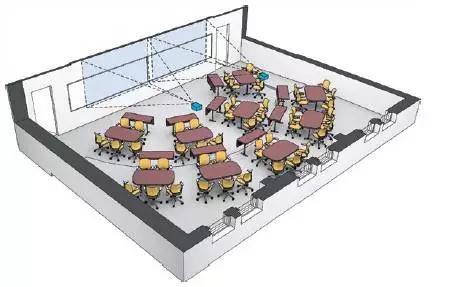
Schematic diagram of a 45-seat group classroom
Hervenor Building, Warrington College, University of Florida
The latest classroom design attempts to apply the basic principles of the Harkness teaching method to the larger classroom. One of the applications is the group classroom, which takes into account both teaching and group discussion-based teaching methods, with a maximum of 100 seats. The small group classroom consists of fixed desks that can seat five or six students. Three students at each table face the teacher directly, and the other two or three can rotate the chair, or face the teacher, or face the group discussion table. In the traditional classroom, teachers always stand in front of the classroom, but the design of small group classrooms allows teachers to try a variety of classroom layout and teaching strategies. In the same space, small group classrooms can carry out teaching, class discussion and group discussion.
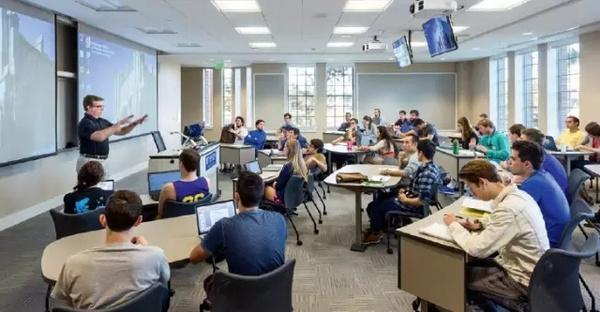
Group classroom in group discussion mode
Hervenor Building, Warrington College, University of Florida
Small group classrooms were first designed for business education, and then prevailed in subjects such as language teaching. The disadvantage of this kind of classroom is that each student occupies a larger classroom area than the traditional classroom, and its advantage is that it can be used for group learning and teamwork during non-lecture hours.
The "upgraded" classroom (the undergraduate teaching environment project, which is student-centered and advocates active learning) practices the group classroom and the Harkness teaching method based on the group principle, but the classroom layout is more loose than the group classroom. Make full use of the latest development of teaching technology.
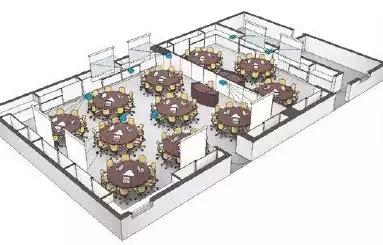
Schematic diagram of a separable 99-seat "upgrade" classroom
Natural Science Center of Ithaca College
Similar to the Harkness teaching method, it requires students to complete their own preview before class and discuss their understanding of the course materials in class. Like the group classroom, part of the time in the "upgrade" classroom is spent lecturing (usually at the beginning of the class), and most of the time is spent doing experiments, group discussion solutions, and classroom discussions. all these are based on teaching software and simulation teaching. The "upgrade" class, once regarded as a new attempt to the traditional undergraduate basic physics course, has now been extended to colleges and universities around the world and used in science and mathematics courses with a large number of electives. In 2015, a professor at Ithaca College published a paper on the development and results of the project to "upgrade" the classroom of its Natural Science Centre, which can accommodate 99 people. The paper shows that after adjusting the curriculum to adapt to the new teaching space, the students' academic level continues to far exceed the national average, reflecting the relationship between the academic level and the classroom structure.
Group classrooms and "upgraded" classrooms are two examples of recent trends in classroom design, both of which incorporate Harkness's ideas and the latest developments in information technology and teaching technology. Both of them can be classified as flipped classroom, combined with autonomous learning outside the classroom and group discussion and problem discussion in the classroom. In a flipped class, the order of class and homework is reversed. Students watch lecture videos or complete other online learning modules before class, so that class time can be used to initiate discussions, complete group exercises, or carry out other projects. The Harkness teaching method has its limitations, because a teacher can only teach a small group of students, while group classrooms and "upgraded" classrooms allow teachers to teach 100 people at the same time in a non-lecture form, which greatly overcomes this inefficiency.
Hervenor Building-Warrington School of Business Administration
The Hervenor Building of the Warrington School of Business Administration at the University of Florida is the latest base for undergraduates and the latest example of applying these classroom design strategies. Among business schools in the United States, Warrington College is large, with about 5000 undergraduates studying here at the same time, supporting more than 30 student organizations and multiple career and leadership development programs. The latest classroom design and teaching methods have led the design of the building, including many types of classrooms. Chinese universities can learn from the innovative design of the Hervenor Building and make effective use of classroom space and teachers' time.
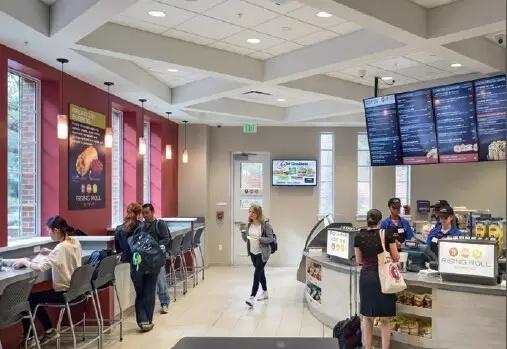
The coffee bar next to the study room in the Hervenor building
Hervenor Building, Warrington College, University of Florida
Hewena Building is a three-story teaching building with an area of more than 5000 square meters, with a total of 9 classrooms, a student activity center for temporary meetings, 16 group discussion rooms, a large multi-functional area for holding meetings or events, 29 academic guidance offices, a technical support center, and a small coffee shop. These teaching spaces, student service facilities and social places are gathered in the same building, which enriches students' learning experience and effectively supports the flipped classroom teaching method of the college.

Schematic diagram of the student activity center and the adjacent group discussion room
Hervenor Building, Warrington College, University of Florida
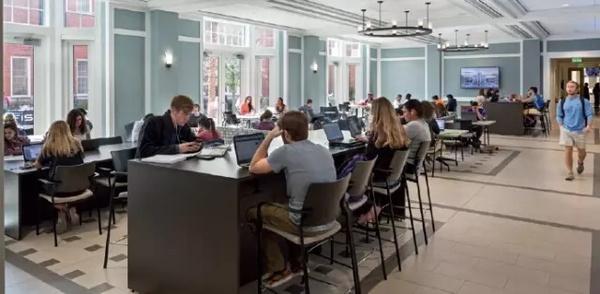
Student activity center
Hervenor Building, Warrington College, University of Florida
Warrington College is a leader in transforming large classrooms into small classrooms to support flipped classroom teaching. In the past, most Warrington undergraduates took large classes in large classrooms, but now they are in small classrooms, allowing most students to participate in remote videoconferences or podcasts to review the class content. The space saved by this change is used to build group discussion rooms, tutoring centers, student study rooms, and other spaces for individual study or group discussion.
The group discussion room in Hervenor Building is open to students all day. These rooms can hold five or six people, sitting around the table, they are built around the comfortable study room, near the coffee shop.
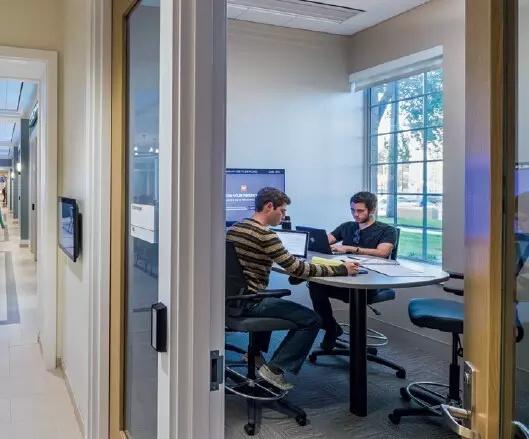
Group discussion room
Hervenor Building, Warrington College, University of Florida
The student center in Hervenor Building provides space for both cooperative and independent students. Students gather here before and after class, eat something, and then study by themselves or in groups. The student center is a combination of movement and stillness, in which all kinds of office furniture can allow individuals and groups to rest or work. The student center and the nearby group discussion room in Hervenor Building enrich students' learning experience and provide environmental facilities for out-of-class learning and cooperation. These facilities also provide a social platform and identity for students who learn through online courses rather than traditional classrooms.
The second floor of the Hervenor Building is an academic achievement center that supports the individual learning needs of students. In the academic Achievement Center, students sit with teachers, academic counselors and teaching assistants. Regardless of the professional level of the students, the students will face to face with the teacher and get the teacher's one-on-one attention and guidance.

Schematic diagram of academic achievement center
Hervenor Building, Warrington College, University of Florida
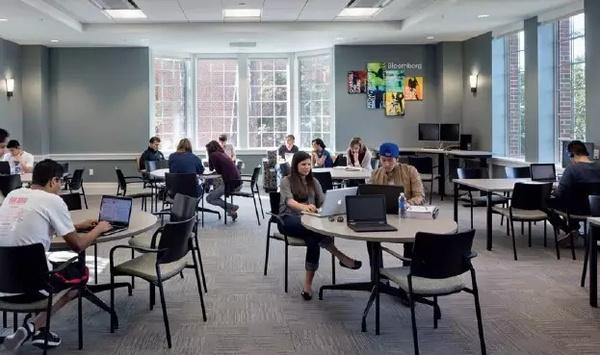
Academic achievement center
Hervenor Building, Warrington College, University of Florida
In order to cope with the rising number of admissions and scarce resources, and to optimize teaching, American universities have made many fundamental changes in the design of classrooms and teaching buildings. Chinese colleges and universities can also learn from these changes. A survey of 18000 Chinese students conducted in 2012 showed that many students are seeking to replace teacher-centered, teaching-based teaching methods. Warrington's experience shows that the space saved by cutting large classrooms can be used to reallocate support for one-on-one or group learning, both of which are good for academic performance. It will also attract the active participation of a new generation of students who have been looking forward to the benefits of a technology-centric, team-based classroom.
Note: the writer is Graham S. Wyatt is a partner at Robert Stern Architects. Photo copyright: all photos of Hervenor House are provided by Francis Dzikowski/OTTO.
Important Notice :
前街咖啡 FrontStreet Coffee has moved to new addredd:
FrontStreet Coffee Address: 315,Donghua East Road,GuangZhou
Tel:020 38364473
- Prev
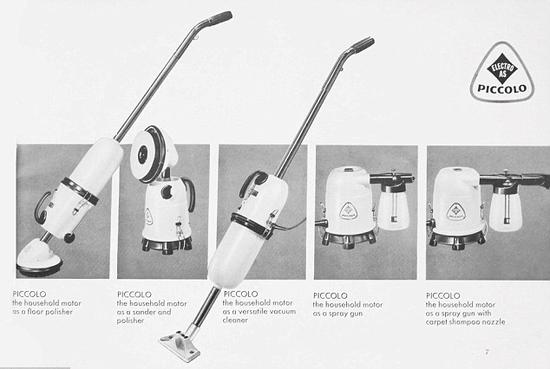
Magic small household appliances made 90 years ago: being able to make coffee can sweep the floor and surprise you.
A small multi-functional household appliance made in Germany in 1925. The appliance can help the couple clean the house, polish the floor, make coffee and even help them prepare dinner. According to the Daily Mail of December 28, British couple Mary? Mary Waite and her husband Ivor own a small multi-purpose household appliance made in Germany in 1925. The
- Next
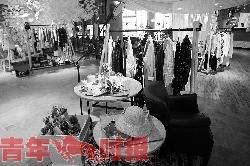
City dwellers are really good at playing the perfect combination of fashion and coffee.
Come to the bookstore to buy handmade works, drink coffee, come to the market to see the play, you city people really know how to play acronym, used to describe bold, innovative actions. Hangzhou city people who know how to play will not let the endangered bookstore Go Die easily! This year, Hangzhou's private independent bookstores abandoned their previous single image and opened several new stores, gradually becoming a new place for leisure; foreign-style cafes will naturally play.
Related
- What is the standard process for the purpose of coffee cup testing? What is the difference between hand-brewed coffee and cup testing?
- How to use hand-brewed coffee paragon small golden balls? How does cold coffee lock in the aroma of coffee?
- Is American coffee black? What is the difference between American coffee and drip coffee?
- Unexpected! Well-known tea beverage brand Lele Tea will withdraw from the Zhengzhou market!
- Starbucks enters the fashion and beauty industry?! Netizen: Give me an ice American eye cream
- Why can American refills for free? The difference between Americano and American drip pot coffee
- Being chased out of the rain in front of Starbucks?! Store: Sheltering from rain under umbrellas poses a safety hazard
- The white moonlight has changed?! Lucky launches "Big Winter Pear American"
- Hand-brewed coffee three-stage method, high-sweet and universal brewing method to share! What does the high sweet water level of hand-brewed coffee mean?
- What is the difference between raw, refined and full espresso coffee? How to extract espresso and taste good?

